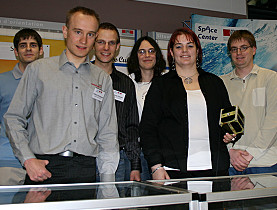Satellite makes final trip before lift-off
The first all-Swiss satellite has been dispatched to its launch site in India.
SwissCube was designed by university students and built entirely in Switzerland. It will be placed in orbit later this summer, at an altitude of 400-1,000km, and will circle the Earth once every 90 minutes.
It will map the airglow, a light phenomenon observed by astronauts.
The Lausanne Federal Institute of Techology-led project is one of nine CubeSats accepted by the European Space Agency (ESA) for the first mission of the new European rocket Vega. It was pitted against 22 proposals submitted by students at European universities.
CubeSat is a generic name for a satellite measuring only 10x10x10cm and weighing not more than one kilo – rather like a carton of milk. Within these constraints, the students were free to design whatever they liked.
The 820g SwissCube is not only small, but also cheap, having been put together from parts that are commercially available.
It contains nearly 1,000 components, including a mini-telescope, 16 electronic cards and 357 different wires welded in more than 700 places to the components.
Its solar panels will have a power of 1.5 watts, barely more than a mobile phone.
swissinfo.ch and agencies

In compliance with the JTI standards
More: SWI swissinfo.ch certified by the Journalism Trust Initiative











You can find an overview of ongoing debates with our journalists here . Please join us!
If you want to start a conversation about a topic raised in this article or want to report factual errors, email us at english@swissinfo.ch.